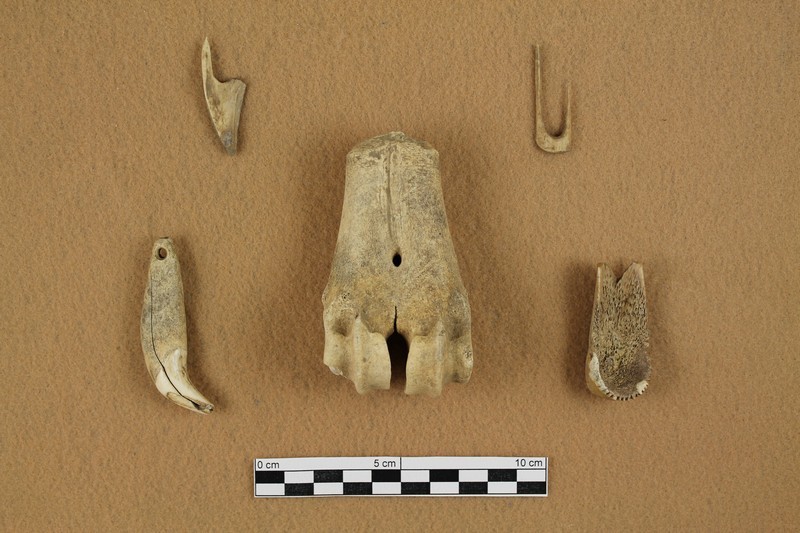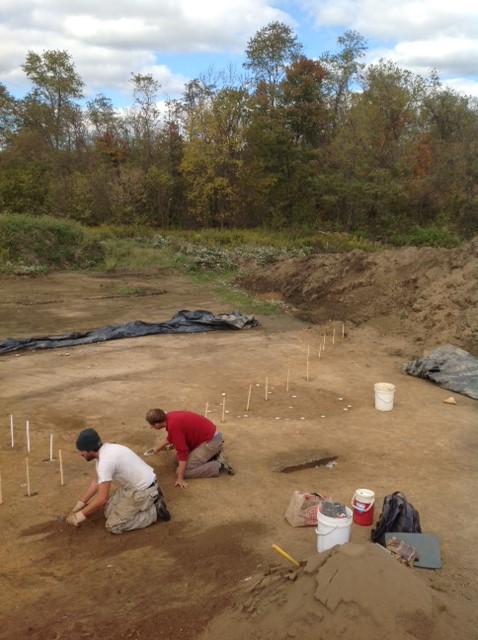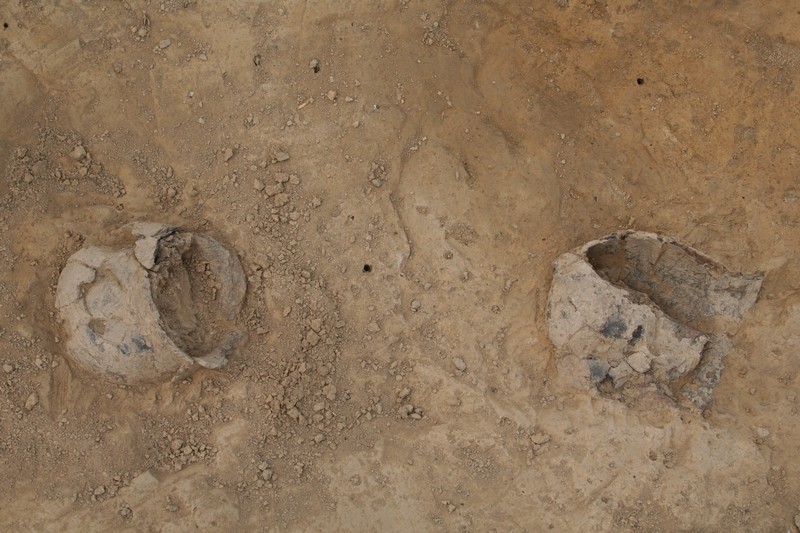by Christine Davis, Christine Davis Consultants, Inc.
After 30 years of excavating archaeological sites in Pennsylvania, I’m often asked about my most amazing discovery. I would not hesitate for a moment to say it was our large-scale excavation of the Freeport Site in Freeport Township, Greene County, which revealed an extraordinary Native American archaeological site dispersed across 11 acres of land above the Monongahela River.
The Freeport Site was recorded in the 1950s and had been excavated by university field schools for nine years. When our archaeologists arrived to conduct a professional excavation for a compliance project, we thought the plan was to complete excavations of an Adena burial mound and the adjacent small Native American village site but nothing prepared out team for what we found The Adena people belong to a Native American culture from the Early Woodland period (about 500 B.C. to A.D. 100) that was predominantly located in the Ohio River Valley; generally the modern-day areas of southern Ohio, western Pennsylvania, and West Virginia. The Adena Cultural Complex is a term that archaeologists use to describe sites that fall within this timeframe and topographic area, and also contain a specific suite of cultural markers. Some of the cultural markers for this complex include populations occupying dispersed hamlets, burial practices with ceremonialism focusing on burial mound construction, circular houses within hamlets, the use of ceramics, and the use of storage pits. You may remember that PA SHPO archaeologist Mark McConaughy talked about another Adena mound in Western Pennsylvania at McKees Rocks earlier this year.
Based on radiocarbon dates, Native Americans had occupied the Freeport Site intermittently over a period of nearly 2,000 years, but the more intensive occupation took place about 600 years ago. The site did include a small Adena burial mound but we did NOT find a typical circular village with round house patterns. What we found were unique crescent- shaped clusters of features and patterns for structures we had never found on any other site. The artifact assemblage was not typical either. For example, there were many ceremonial objects but few arrow points.
The burial mound at the Freeport Site was a symbolic place for over 2,000 years. Excavating even part of a mound is a rare opportunity in Pennsylvania archaeology because most mounds have been looted, plowed over, or leveled and this mound was no exception. There appeared to be almost nothing left of the mound but as our team began work, we were astonished to find 31 features including a large cremation basin and over 3,000 artifacts.
And there were two other exceptional new discoveries. First, the mound had been significantly enlarged sometime in the prehistoric past. Second, encircling the entire mound was a Sacred Circle. A stunning radiocarbon date revealed that the Sacred Circle and this enlargement to the mound dated centuries AFTER the original mound was built. It was not just an Adena mound, there was something greater to be found.
As we continued to strip the plowed soil from the site, three large earthworks were found. A coordinated physical effort by prehistoric people would have been needed to build and align these earthworks. Skills in astronomy, design, and planning were essential. Our understanding of how the builders of earthworks imagined and created these architectural features continues to fascinate and perplex American archaeologists.
As the connection between the habitation sites and the mound became more apparent, our excavation of this complicated site continued to challenge established hypotheses. Instead of the round wigwams typical of Native American villages in western Pennsylvania, we discovered a large rectangular building, sweathouses, fences, screens, and other unique structures. What did it all mean?
Ultimately, our team identified and mapped 448 archaeological features on the Freeport Site. There were human burials, caches, earth ovens, hearths, pot holders, an intentional puppy burial, and a possible buried drum. There were features involving feast preparation, pottery production, nut processing, and even a possible tattoo “parlor” with catfish spine needles and a paint palate.
Given these amazing and unique features and architectural components, we searched to understand the site. Could we establish connections between the archaeology of the prehistoric past and living tribes?
It was not until we delved into the complex world of Native Americans and their relationships with animals, plants, the spirit world, and the land that we found the information we needed to form a new hypothesis. The site clearly involved rituals. But identifying patterns of ritual behavior remains one of the most difficult problems in archaeological studies of prehistory.
What emerged after three years of research, excavation, and analysis was that the Freeport Site represents a prehistoric Medicine Society, unlike any other site found in western Pennsylvania. Medicine Societies functioned not only for healing but for training both male and female shaman. The presence of the sick and dying would be anticipated and, in fact, human remains were found in 24 features. Eleven of the burials contained only small fragments suggesting the ancestors were moved soon after the ceremony ended.
During the archaeological excavations of these human remains, our team followed detailed protocols as agreed upon by the tribes and agencies involved. The remains were then transferred to a tribal representative and reburied on their reservation before nightfall.
These discoveries were profound. Every crew member involved in the excavation was deeply affected.
At the conclusion of our field work at the Freeport Site, over 31,000 artifacts and 34,000 botanical remains were found. Beautifully incised ceramics, stone tools, arrow points, stone tablets, and carved stones were carefully analyzed.
The site contained the largest assemblage of bone tools, decorative elements, gaming pieces, and other bone artifacts ever found in this region. The analysis of animal bone also proved an important contribution to our understanding of cultural, social, and ritual practices.

Some of the artifacts uncovered during the excavation included bone pendants, fish hook and a notched spoon.
The excavations at Freeport enriched our understanding of the past and revealed a cultural landscape never before observed on an archaeological site. This body of work provided a new perspective to understanding the complex lives of Native American people who created and maintained these sites of healing and ritual, a view far different from the long held myths and legends of American history.
The support and encouragement of PA SHPO staff members Kira Heinrich, Doug McLearen, and Mark McConaughy were vital throughout the excavation. Alpha Natural Resources provided funding for the project.
Christine Davis is the president of Christine Davis Consultants, Inc., a cultural resources management firm in Verona, PA. Christine has completed various types of history archaeology projects in Pennsylvania for over 30 years.


Leave a Reply